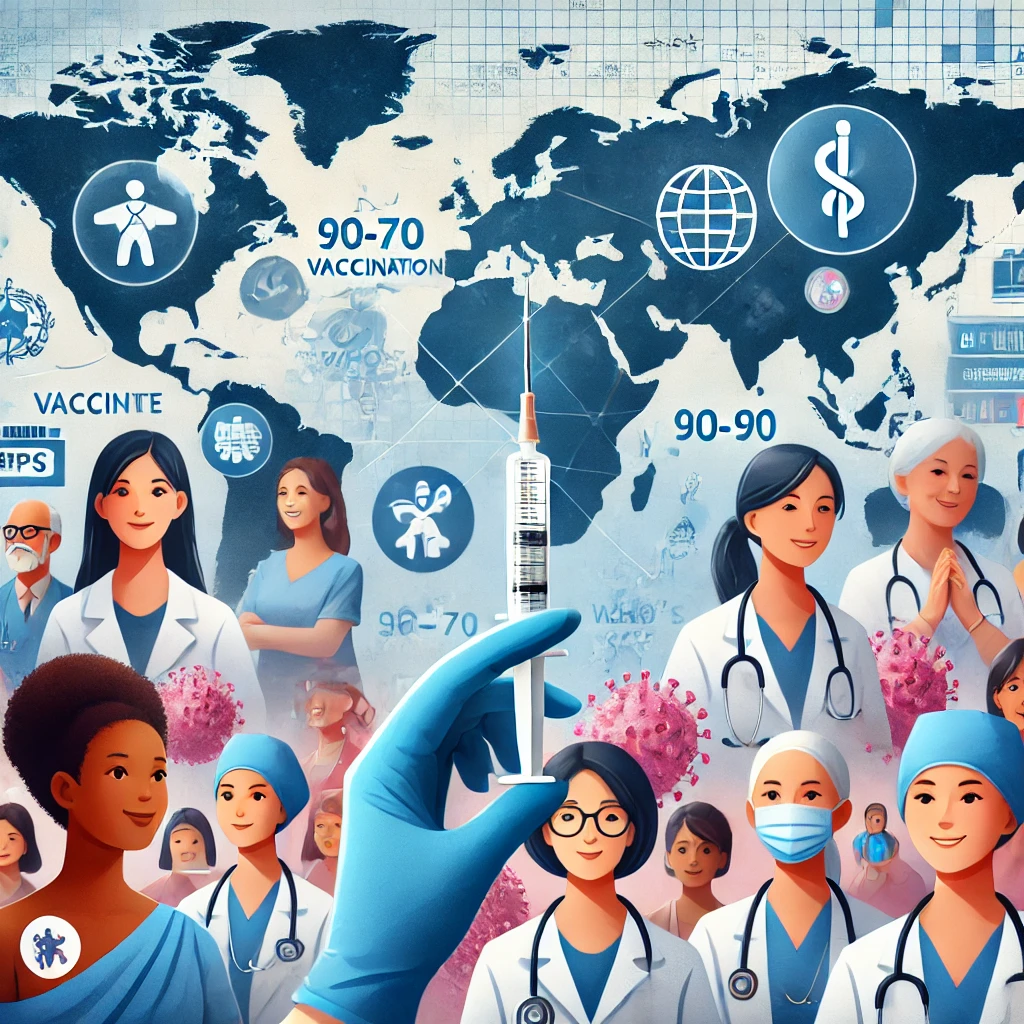Global Strategy to Eradicate Cervical Cancer by 2030: WHO’s 90-70-90 Initiative on HPV
The World Health Organization's 90-70-90 strategy aims to eliminate cervical cancer by 2030 through widespread HPV vaccination, screening, and treatment. Despite significant progress, especially in countries like Australia, global challenges remain, particularly in low- and middle-income regions.

Human papillomaviruses (HPV) are the most common sexually transmitted pathogens globally, causing a range of clinical conditions from benign warts to various cancers in both men and women. Cervical cancer, strongly linked to persistent high-risk HPV (HR-HPV) infections, accounts for nearly all cervical cancer cases. Research from institutions such as the University of Belgrade’s Faculty of Pharmacy and the Oncology Institute of Vojvodina underscores the critical role of HPV vaccines in preventing these infections. HPV vaccines, including bivalent, quadrivalent, and nonavalent formulations, are highly effective in preventing infections from the most oncogenic HPV strains. These vaccines, particularly the nonavalent version, are being increasingly adopted worldwide and are administered to children as young as nine, though routine vaccination typically occurs between ages 11 and 12. Despite the availability of vaccines and various treatment options like surgery, radiation therapy, chemotherapy, and advanced targeted therapies using monoclonal antibodies, substantial efforts are still required to meet the World Health Organization’s (WHO) elimination targets. The WHO has recognized cervical cancer as a global health issue and launched a strategic initiative to eliminate it.
The WHO’s Ambitious 90-70-90 Strategy
The WHO’s 90-70-90 strategy aims for 90% of girls to be fully vaccinated against HPV by age 15, 70% of women to be screened for cervical cancer by age 35 and again by age 45, and 90% of women with cervical disease to receive appropriate treatment. This ambitious plan addresses the high burden of cervical cancer, particularly in low- and middle-income countries, where the majority of cervical cancer deaths occur due to limited access to vaccination, screening, and treatment. The introduction of HPV vaccines has significantly reduced the prevalence of HPV-related diseases in countries with high vaccination coverage, demonstrating the potential for herd immunity. Countries like Australia have shown remarkable success with their HPV National Immunisation Programme, leading to a substantial decline in HPV prevalence and related diseases. Australia was one of the first countries to implement the HPV National Immunisation Programme using the quadrivalent HPV vaccine for girls since 2007 and extended to boys in 2013. The gender-neutral approach is considered vital for reducing the disease burden in men, particularly men who have sex with men (MSM) who would not benefit from female-only HPV vaccination. In January 2018, the nonavalent HPV vaccine Gardasil 9 replaced the quadrivalent HPV vaccine in Australia, showing a dramatic decline in HPV prevalence in vaccinated women.
Vaccine Success Stories: Australia and Beyond
The effectiveness of HPV vaccination is further supported by studies in Nordic countries, where the quadrivalent HPV vaccine showed no breakthrough cases of HPV16/18 CIN2 or worse in vaccinated women over 12 years. The highest efficacy of HPV vaccines is among the young population, with the recommendation for vaccination before they become sexually active and before having contact with HPV. The nonavalent HPV vaccine can be administered starting from age 9, but it is best to start vaccination in children aged 11-12 years, with two doses given 6 to 12 months apart. In Serbia, HPV vaccination with the nonavalent Gardasil 9 vaccine has been funded by the Republic Fund of Health Insurance for beneficiaries aged 9-19 years since June 2022. By the end of 2022, a total of 20,130 doses were administered, with the first dose given to 14,164 people.
How HPV Vaccines Work
HPV vaccines work by inducing a strong immune response, with high antibody titers compared to natural infection. The immune response is largely attributed to the structure of the virus-like particles (VLPs) used in the vaccines, which are highly immunogenic and produce long-lasting antibodies. The WHO’s global strategy for eliminating cervical cancer aims to reduce the incidence of cervical cancer to less than four per 100,000 women worldwide by 2030. To achieve this, high coverage of HPV vaccination, screening, and treatment of precancerous lesions are essential. In 2020, less than 25% of low-income countries and less than 30% of lower-middle-income countries had introduced HPV vaccination into their national immunization programs, compared to more than 85% of high-income countries.
Overcoming Global Challenges in Cervical Cancer Elimination
The WHO’s Cervical Cancer Elimination Initiative (CCEI), also known as the 90-70-90 strategy, outlines clear targets to be met by 2030: 90% of girls will have completed their HPV vaccination course by age 15, 70% of women will have been screened for cervical cancer by age 35 and again by age 45, and 90% of women diagnosed with cervical disease will have received appropriate treatment. A mathematical model demonstrating the benefits of CCEI implementation revealed that the median cervical cancer incidence rate could fall by 97% by 2120, preventing more than 74 million new cases of cervical cancer and 62 million cervical cancer deaths. Despite the progress made, global HPV vaccine coverage among girls declined from 20% in 2019 to 15% in 2021, far from the CCEI goal. The COVID-19 pandemic disrupted access to preventive strategies, posing additional challenges to meeting these targets. Efforts must focus on improving awareness, promoting regular screenings, and ensuring the availability of treatment options, especially in low- and middle-income countries, to achieve the WHO's ambitious goals.
- FIRST PUBLISHED IN:
- Devdiscourse
ALSO READ
813 of 1,563 candidates who were awarded grace marks in NEET-UG appeared for retest on Sunday: National Testing Agency.
17 NEET-UG candidates who appeared in May 5 exam from centres in Bihar debarred following detection of malpractice: NTA.
From Anil Kapoor to Kajol, check out who all graced Sonakshi Sinha-Zaheer Iqbal's wedding reception
"Those who mock Uttar Pradesh will face humiliation..": Afzal Ansari reacts to Shashi Tharoor's tweet on UP
"Those who support terrorists will be dealt under Enemy Agents Ordinance: J-K DGP Swain










